Power Cut
While prolonged power cut is uncommon nowadays in Hong Kong, unforeseeable factors such as adverse weather or equipment failure make power cut still possible to happen without prior notice. Power disruptions can extend from minutes to hours, and many foods spoil rapidly without refrigeration.
Although power cut can be inconvenient, especially if you have a lot of perishable food in your refrigerator and freezer, there is no need to panic. The following tips help you keep your food safe while waiting for the power to come back on.
During Power Cut: keep the Fridge and Freezer Shut
Without electrical power, refrigerators and freezers will lose the ability to store foods at safe temperatures. Foods stored in fridges must be at 4°C or less and freezers should store products at -18°C or less to hinder the growth of harmful bacteria and other microorganisms that can cause foodborne illness. In case of power cut, the best thing to do is simply not to open the fridge and freezer, which helps maintain the proper storage temperatures as long as possible. This is to prevent bacteria from growing rapidly in the Temperature Danger Zone ranging from 4°C to 60°C.
In general, if the doors stay closed, food will stay safe for 2 to 4 hours in a refrigerator; 48 hours in a full freezer; and 24 hours in a half-full freezer. Therefore, knowing the time the power cut starts is useful to track how long the refrigerator and freezer have been without power; this will help you determine which foods may be safe to eat and which ones are not.
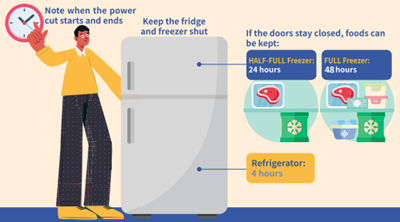
After the power resumes: follow the '4 hour/2 hour rule'
After the power has been restored, people are advised to check the temperature of their perishable foods, considering how long they may have been out of the safe temperature range. For any potentially hazardous foods such as meat, seafood, eggs, milk, dairy products, cut fruits and cooked dishes that have been at temperatures between 4 °C and 60 °C, refrigerate or use immediately if kept for less than 2 hours; use immediately if longer than 2 hours but less than 4 hours; and toss away if more than 4 hours.
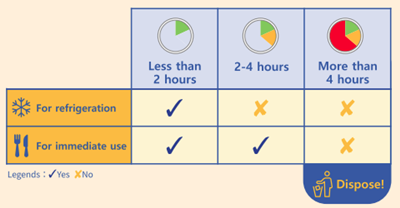
Never taste foods to determine if they are safe to eat, as they might not give off a bad taste or odour. If unsure about the safety of your perishable foods, simply discard them.
On the other hand, non-perishable foods that can be stored at room temperature and are kept in the fridge or freezer may not warrant the bin in the event of a power cut. High acid foods (e.g. mustard, ketchup, jams, pickles), certain processed foods (e.g. peanut butter, butter, bread) and most dried foods are typically kept better in power blackout situations.
In Time of Peace: Prepare for Emergency
In non-crisis times, make sure the refrigerator should be at 4°C or below, and the freezer at -18°C or below.
Ideally, keep appliance thermometers in your refrigerator and freezer. Always keep some ice cubes and frozen gel packs in the freezer. They can keep the freezer full to help maintain the temperature, and keep foods cold should they be transferred to other locations such as a friend or relatives' refrigerator.
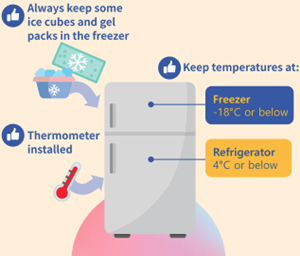
Food can be very expensive to throw away but not as costly as food-borne illnesses which can cause severe health consequences as well as death. If any food is suspected to be deteriorated, it is not worth the risk, especially for young children, the elderly and those with compromised immune systems. It is always best to err on the side of caution - when in doubt, throw the food out.
People should also adhere to the Five Keys to Food Safety during emergencies, protecting themselves and those around them from foodborne diseases.
The Five Keys to Food Safety include:
-
Choose: Choose safe raw materials
-
Clean: Keep hands and utensils clean
-
Separate: Separate raw and cooked food
-
Cook: Cook thoroughly
-
Safe temperature: Keep food at safe temperature
Flooding
During the summer and typhoon seasons, Hong Kong often experiences severe and protracted rainstorms, where flooding may occur in some locations. With the advent of global climatic change, the combination of heavy rainfall, tropical cyclones and warmer temperatures is a recipe for more frequent flooding. Floodwater can contaminate food, and adverse weather might cause local or widespread power cuts, resulting in spoilage of perishable food due to disruption of refrigeration. While the sun shines, it is a good time to review how to prepare for such emergencies and deal with the fallout relating to food safety.
Flooding poses a potential food safety concern. Foods may be inundated in floodwater contaminated with sewage that can carry disease-causing microorganisms such as E. coli, Salmonella, hepatitis A virus and norovirus, as well as other contaminants. Dampened food is also susceptible to mould growth. Therefore, it is important to take proper precautions before and after a flood to ensure food safety.
Before the flood
If flooding is expected, position food storage areas and refrigerators as far away from floodwater as feasible.
Clean-up and Disinfection
After floods, make sure all affected work surfaces, utensils and kitchen equipment are cleaned and disinfected before handling food. If wooden chopping boards and wooden utensils have come into contact with floodwater, dispose of them.
Food Salvage after Floods
When planning to salvage food after floods, it is important not to eat any food that has been submerged in floodwater and has not been packaged in a waterproof container. After discarding any damaged items that exhibit signs of swelling, leakage, rusting or dents, the intact ones can be salvaged for consumption with careful handling.
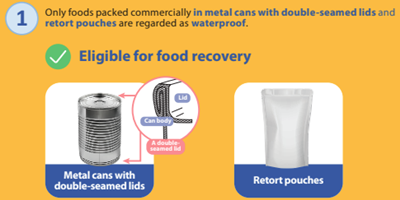

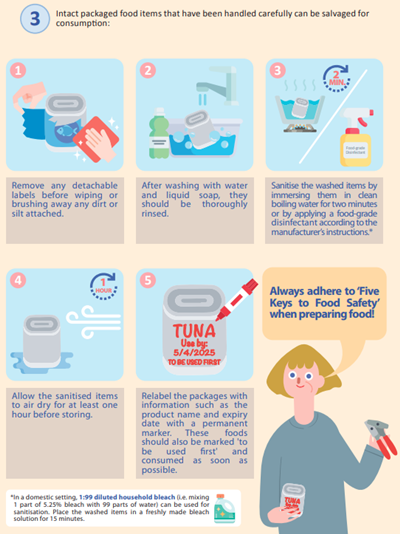
All non-prepackaged foods, as well as those not in a waterproof packaging, such as containers with screw caps, snap lids, pull tops or crimped caps that have come into contact with floodwater should be discarded. Food in paper carton, plastic or cloth packaging, as well as home-canned food, immersed in floodwater should also be tossed away. This is because there are no practical methods of reconditioning or processing to salvage these foods.
Not Eligible for Food Recovery
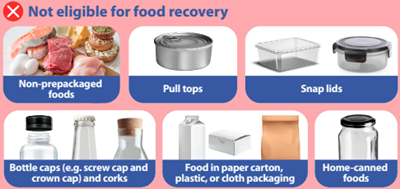
Roles of Food Businesses
Food businesses have the responsibility of ensuring food safety, and should not supply discarded, spoiled or rotten foods damaged by floods or power cuts for human consumption. Defective food products should be set aside, bagged in refuse sacks and tagged as unfit for human consumption. Food businesses have to safely dispose of condemned food items to ensure that they will not be consumed. After emergencies, business should be suspended until thorough clean-up and disinfection is completed in order to prevent foodborne diseases caused by food contamination or poor environmental hygiene.